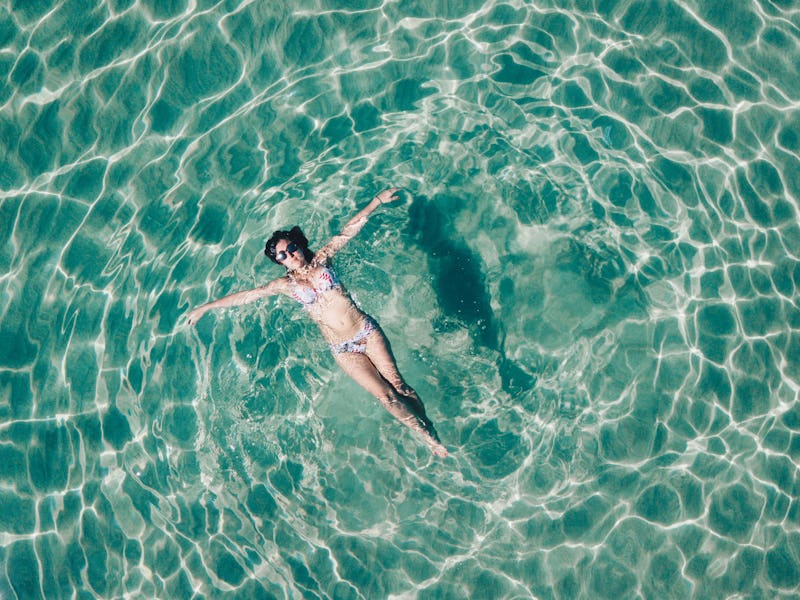Some Ocean Swimming Increases Vulnerability to Skin Infections
The ocean is vast and definitely not sterile.

As children, we learn that the ocean is vast, and we may assume that, by extension, it must be clean. Stub your toe on the beach? No problem. Just wash it off in the saltwater! But, in fact, scientists are increasingly realizing that not only is the ocean not sterile, it’s also home to a vast array of microbes. And new research presented on Saturday at the 2019 meeting of the American Society for Microbiology demonstrates that the bacteria in the ocean can have a profound effect on the human skin microbiome.
The skin microbiome, the colony of microbes that inhabits our body’s outermost layer of protection against the rest of the world, is our first line of defense. In a small study led by Marisa Chattman Nielsen, a Ph.D. student at the University of California, Irvine, researchers observed that swimming in the ocean for as little as 10 minutes can wash away the body’s native skin bacteria and replace them with the ocean’s. The study has not yet been published.
Motivated by past research on people who got sick from swimming in the ocean, Nielsen wanted to find out what role humans’ natural skin bacteria play in protecting against ocean-borne pathogens.
The ocean may be vast, but it's teeming with bacterial life.
To test this idea, she and her team swabbed 30 samples from nine different people’s skin after they took a short dip in the ocean. The first sample was taken once they’d gotten out and air-dried; another was taken after 6 hours; and the last was taken 24 hours after the 10-minute swim. Using next-generation genome sequencing, Nielsen’s team observed that swimming in the ocean washed away the unique skin microbiome from each of the participants, replacing it with one that was much more similar to the ocean’s bacterial profile.
Notably, Vibrio bacteria constituted a major proportion of the post-swim skin microbiome samples. In fact, they composed an even higher percentage of the microbiome on people’s skin than they composed in the ocean water, suggesting they have a special affinity for human skin. This finding highlights a particular concern when it comes to studying how swimming in the ocean can be linked to infections.
Not all species of Vibrio bacteria are pathogenic — meaning they won’t all make you sick — but some of them are truly brutal. Plus, the nastiest one is actually becoming more common. As Sarah Sloat reported for Inverse on June 19, Vibrio vulnificus has expanded its range into waters that are farther north and traditionally much colder than its normal range. This particular species of bacteria is an ugly one that can eat away the flesh of an infected human and potentially result in death.
This is definitely not to say that swimming in the ocean will make you sick. But for anyone who has gotten an infection after swimming in the ocean, perhaps it offers an explanation: The ocean is a living system, not a bathtub.
Abstract:
Background: Skin is the human body’s first line of defense, both physically and immunologically, against invading microorganisms and simultaneously supports the growth of diverse microbial communities. Environmental exposures, including exogenous microbial exposures, can alter the microbiome. Recreational ocean water activities have been linked to microbial infections, and skin infections are most frequently reported. Water activities can simultaneously wash off normal flora and expose skin to potential pathogens in the ocean. The primary objective of this study is to determine if recreational ocean water exposure alters the human skin microbiome and how long these changes persist.
Methods: Samples were collected from a section of skin on the participants’ calves using saline-moistened, rayon-tipped swabs. Samples were collected before swimming, after swimming for 10 minutes in the ocean (once the skin was air-dried), and at 6 hours and 24 hours post-swim. After DNA extraction, the samples were analyzed by next-generation sequencing using the 16S rRNA gene V4 variable region. Data analysis was performed using Qiime and R Studio. A total of 30 samples, from 9 participants were analyzed.
Results: Ocean bacteria, including potential pathogens, are acquired from ocean water exposure. They are present on participants’ skin after swimming and remain for at least 24 hours. Alpha diversity analysis indicated that intrasample diversity was increased after swimming. Beta diversity analysis revealed that the skin microbial communities on all participants before swimming were different from one another, but immediately after swimming, all participants’ microbial communities were tightly clustered, indicating that the communities were no longer different. As time elapsed, the microbial communities began to trend toward baseline (before swimming), and normal commensal flora established dominance.
Conclusion: We have determined that recreational ocean water exposure changes the human skin microbiome, and waterborne microbes persist on the skin for at least 24 hours. This research has provided insight into how the human skin microbiome is altered in response to ocean water exposure and this information can be used to help protect people as they continue to enjoy marine environments.